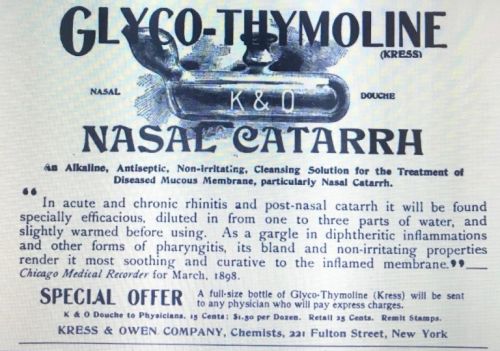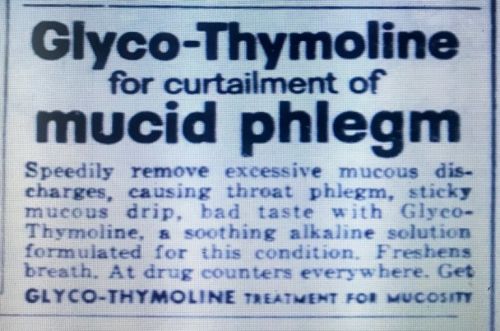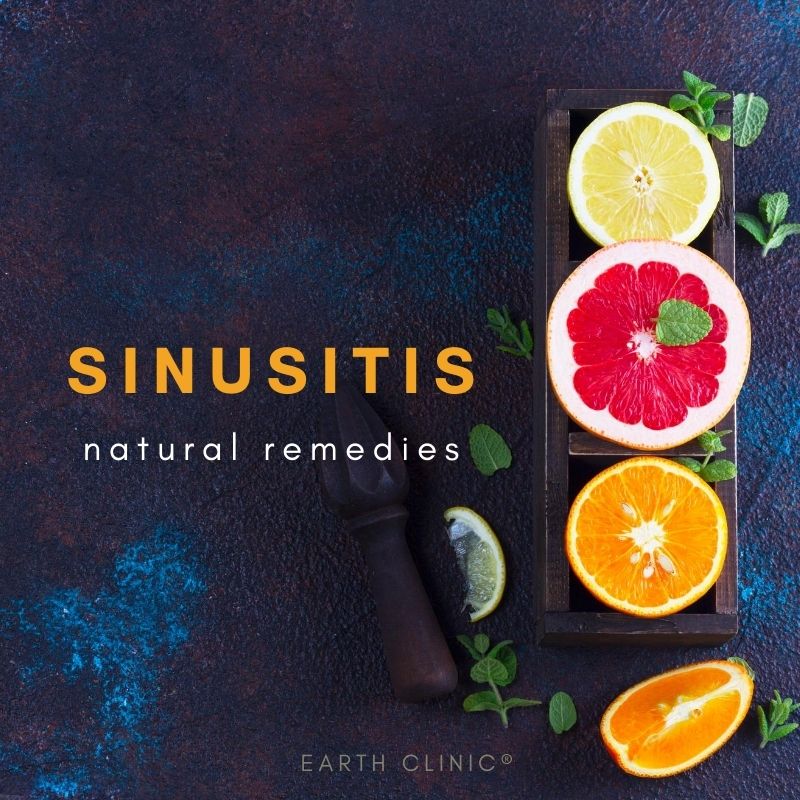Warning on Levofloxacin

You also might be interested in this article I wrote on torn tendons and ligaments in a friend which presumably was caused by at least three courses of Levofloxacin:
https://www.earthclinic.com/cures/collagen-for-torn-ligaments.html
Art
Open Nasal Passages Trick
★★★★★

Everyone can flare their nostrils, and they can close the nasal passages when in the water. So we have some control of muscles in that area. The good news is that the muscles continue up into the sinuses, but we haven't learned to use them yet.
So here's the trick: Flare your nostrils, then visualize flaring them up a bit higher. Do this several times a day and you will begin to have control over those unused muscles. Every day you will be able to open the passages a bit higher up. It only took about a week before I was breathing freely through my nose. Try it.
Glyco-Thymoline (aka Listerine)
★★★★★

This paper is based upon the study of 193 Edgar Cayce readings (1901-1944) wherein Glyco-Thymoline (aka Listerine) was prescribed in one or more ways.
Glycol-Thymoline dates back to the late 1800's, when it was advertised as: An alkaline, antiseptic, non-irritating, cleaning solution for the treatment of diseased mucous membrane, especially nasal catarrh.
Listerine is a common item found in almost every drugstore and supermarket. It has many of the same ingredients as Glyco-Thymoline (see below). Listerine, named for Dr. Joseph Lister, was invented it as a surgical antiseptic and disinfectant in 1879, and has been used as a treatment for gonorrhea, post surgical wounds and even as a floor cleaner, among others. Despite its long and varied history, it didn't become known exclusively as a mouthwash until the 1970s.
Both products were cutting edge technology in their day. Glyco-Thymoline can be purchased thru Amazon.
A medical paper entitled “Chronic Nasal Catarrh and what the General Practitioner Can Do for it, ” presented in May, 1893, mentioned that Kress introduced Glyco-Thymoline to the medical profession around that time.
Over the years, advertisements for Glyco-Thymoline focused primarily on treatment of the nose and throat. One, from December 1899, included this quote from the March 1898 issue of the Chicago Medical Recorder.
In acute and chronic rhinitis and post-nasal catarrh it will be found specially effacious, diluted in from one to three parts of water, and slightly warmed before using. As a gargle in diphtheritic inflammations and other forms of pharyngitis, its bland and non-irritating properties render it most soothing and curative to the inflamed membrane.
Many early advertisements promoted the use of Glyco-Thymoline in concert with a nasal applicator called the Birmingham Douche. (A precursor to today's Neti Pot?) Their 1899 advertisement printed in the American Journal of Surgery and Gynecology was one that promoted them together under a single process. The application of Glycolic-Thymoline (Kress) to the nasal passages with our Birmingham Douche, obviates the danger of drawing Muco-Pus into the Eustachian tube.
https://baybottles.com/2019/05/05/glyco-thymoline-kress-owen-co/
Edgar Cayce readings about Glyco's use as a pack and nasal spray for sinusitis, and inflammation of the air cavities (sinuses) in the skull that open into the nasal cavities. For frequent sufferers, this ailment is painful experience: congestion, headaches, pain when touching the forehead and cheeks—even toothaches, fever, or chills are often part of the uncomfortable symptoms. A person may also feel sick in general if the infection has spread beyond the sinuses.
Sinusitis is caused either by an allergy or by a viral, bacterial, or fungal infection. During a cold, the mucous membrane of the nasal cavity will swell, blocking the sinus openings. Then air from the sinuses is absorbed into the bloodstream, decreasing the pressure inside the sinuses and resulting in a painful negative pressure. The vacuum created by this condition provides a breeding ground for micro-organism's. As white blood cells and more fluid enter the area to fight the microbes, pressure increases, creating more pain.
Glyco-Thymoline, according to Cayce readings, it can be used as a treatment for mucosity (abnormal excessive mucous secretion) and for several other types of internal and external application. Glyco-Thymoline, can be used as a nasal spray, nasal douche (neti-pot) or as a gargle, acts to detach and help remove sticky, mucous accumulations from nasal and throat passages. Also suggested as a soothing, cleansing, non-irritating solution for feminine hygiene, oral hygiene, babies' simple skin irritations, minor burns, poison ivy, sunburn, and chapping. https://www.si.edu/object/nmah_209672
Glyco-Thymoline contains all natural ingredients. Its previous label stated “Treatment for Mucosity, ” but its present label denotes it as a “Mouthwash and Gargle.” Most often it is used in small amounts or in diluted form (equal parts with water or one part Glyco-Thymoline to two parts water) when used in cavities of the body. For oral hygiene, for example, it can be used full strength. The manufacturer reports that, though the label was redesigned to conform to Food and Drug Administration regulations, the formula has not changed since Cayce's day. A number of directions for its use as given in the Cayce readings closely coincides with the manufacturer's recommendations.
Glyco-Thymoline Ingredients. Water, Glycerin, Alcohol (3.27%), Sodium Borate (Borax), Sodium Benzoate (widely used food pickling agent), Sodium Bicarbonate (Baking Soda), Carmine (natural red 4), Sodium Salicylate (is a sodium salt of salicylic acid), Oils of Menthol (Peppermint), Eucalyptol (Eucalyptus), Abies Sibirica (Fir Needle) Oil, Thymol (Thyme), Methyl Salicylate (Wintergreen).
Listerine Active Ingredients: Eucalyptol (Eucalyptus) 0.092%, Menthol (Peppermint) 0.042%, Methyl salicylate (Wintergreen) 0.060%, Thymol (Thyme) 0.064%
Inactive Ingredients:
Water, Alcohol (26.9%), Helps to dissolve the oils in mouthwashes
Benzoic acid, Prevents microbial growth and helps adjust pH in the product
Poloxamer 407, Helps mix the oils and water and helps remove food particles
Sodium benzoate, Provides sweetness to enhance the flavor
Caramel, coloring agent
Note: Dollar Tree discount store has a spearmint mouthwash with similar ingredients to Listerine but at 21% alcohol level. This is what I use.
Preparation and Use of Packs
According to Edgar Cayce reading and the preparing of Glyco-Thymoline pack, these general suggestions were included with the reading:
“Use 2 to 3 thicknesses of cotton cloth well saturated with the commercial strength Glyco-Thymoline and apply over affected areas, or areas specified for your particular case. An electric pad may be used to keep the pack warm. A piece of oil cloth (or plastic) may be put over the pack, after it is placed on body, to prevent soiling linens, etc. Apply for 20 to 30 minutes, to an hour at the time. In cold weather, place the bottle of Glyco-Thymoline in a pan of hot water to take the chill off before using it for the pack” (Cayce)
Length of time for the packs and their frequency of use varied as people's individual physical conditions warranted. Depending upon one's health needs, Glyco packs could also be placed along the spine before osteopathic treatments were administered to “relax the area to be adjusted” (Cayce)—across the sacral area “to aid in eliminating the accumulations there, through assisting the system to absorb poisons” (Cayce), and over the abdomen for a variety of intestinal and bladder ailments.
Except for a few instances in which the person specifically was told not to use heat, Glyco-Thymoline was to be applied as a warm compress across the face, covering the forehead, nose, and upper cheeks, under which the sinus cavities rest. According to one reading, “…the heat causes the certain oils in the elements to loosen themselves, so as to enter into the cavities of the nasal passages and into those areas so distressed at times” (Cayce). This fifty-four-year-old woman had a chronic sinus condition and was advised to use a nasal spray as well as a pack two to three times a day. In several other cases osteopathic adjustments were to be undertaken in conjunction with the packs. Cotton cloth or gauze was the recommended material.
Preparation and Use of Nasal Spray
Add 1:1 ratio Glyco Thymoline to distilled saline water mixed with baking soda into 1 oz nasal spray bottle. Spray each nostril several times daily til infection is gone.


Apple Cider Vinegar
★★★★★

Back to the drawing board. So I'm thinking, why not use ACV (w/mother)? I changed out the garlic tea for ACV in distilled water and WOW! It dried up my congestion in 2 hours, opened up my clogged eustachian tubes in 4 hours, and completely cured within 24 hours. All without a trip to the doctor office, antibiotic, flonase nasal spray, etc… and a fat bill to go with it. I was blasting each nostril every hour or so. It has been 3 weeks now and I'm still clear. If my nose feels stuffy, I blast it with the ACV pump spray and I'm good for the day. Try it, you won't regret it.
Now for side effects. It burns alittle. If it ain't burning, it ain't working. I notice a loud ringing in my ears. I'm sure it had something to do with the clogged eustachian tubes. They had been clogged for months. It does go away after a few hours. You will taste ACV in the back of your throat.
Apple Cider Vinegar Nasal Spray: The ACV nasal spray should provide relief to those suffering from nasal congestion. ACV thins out and eventually removes mucus that is blocking passages in the nasal sinus. The antimicrobial properties will kill the pathogenes causing the sinusitis.
Procedure:
-
Mix 5 to 10 drops raw apple cider vinegar (w/mother) with 1 tablespoon distilled water.
-
Pour the ACV- distilled water mixture to a clean and dry nasal mist pump sprayer that the pump can be screwed off. Got mine at Dollartree.
-
3 Spray the ACV- distilled water mixture to the affected nostril.
-
Spray at least thrice daily until you get rid of sinus infection.
This remedy is expected to provide relief to nasal congestion within 12 hours.
Apple Cider Vinegar, Lugol's Iodine
★★★★★

I am just going to get straight to the point what helped me after years (tried everything, including all recommended natural remedies):
Did not want to make nasal irrigations with ACV (too complicated and too much work), but googled and found a recipe for DIY sprays with ACV instead: 1 tablespoon distilled water + 5-6 ACV drops. Just spray into nostrils. OK. Done - helped almost instantaneously. So what's new here?
Well since after a while I had to repeat the process, I realized ACV was great but not perfect. So I decided instinctively to add 2-3 drops of Lugol's iodine solution to it and see what happens. And - what happened? My nose is 100% decongested now. Later on I read iodine does not only help against bacteria and fungi, but also in case of allergic rhinitis/sinusitis. Must-try! (I seldom post anything anywhere, but simply HAD to make an exception this time! Good luck!
Oil Pulling
★★★★★

I've had sinusitis for years now and am not crazy about using sinus sprays all the time. A friend told me about oil pulling not only for sinus but for healthy teeth and actual help with cavities. I don't usually try 'fad' things, but I bought some virgin coconut oil and gave it a try.
At first, ten to twenty minutes of swishing oil about in the mouth bothered me, but I got accustomed to it and over the past six months, both my oral health and sinus condition have improved. I haven't had a sinus infection in months and when I 'chew' the oil I can feel the sinuses loosening when they're blocked. I recommend you try it if you have sinus issues or tooth/gum problems as well.
Coconut Oil
★★★★★

Sauerkraut
★★★★★

Apple Cider Vinegar
★★★★★

Hi there. So for a whole month I have been suffering with sinusitis. It started off as a cold that wouldn't go away. The sinus blockage went from bad to worse. Dairy products made it even worse. So realised that needed refrain from dairy products too. Tried steaming with ACV and water. Each time I did it it helped but came back. So I decided to use ACV with less water so that it will be more concentrated. Oh boy oh boy just that one treatment and I felt like a new person.
Did it the second time and now I feel back to normal. Completely. I am glad I didn't agree to take the antibiotics!
I also have been drinking lemon juice with honey on a daily basis.
ACV works like magic.... after a whole month of suffering for nothing!
It was quite strong... so u must close your eyes and mouth. I use the face steamer... so that the steam is not too strong... put over a towel and that does the trick!
Thank you earth clinic. Wish everyone good health and a speedy recovery!



